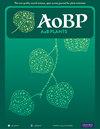共生固氮降低了低氮供应量(而非高氮供应量)条件下氮获取的地下生物量碳成本
IF 2.4
3区 生物学
Q2 ECOLOGY
引用次数: 0
摘要
许多植物物种与固氮细菌形成共生关系。通过这种共生关系,植物将地下的光合作用分配给细菌,以换取从大气中固定的氮。这种共生关系是许多生态系统中碳和氮循环之间的重要纽带。然而,由于植物对共生固氮的投入往往会随着土壤氮素供应量的增加而减少,因此人们对土壤氮素供应梯度下这种关系的经济性还不甚了解。在这里,我们使用了一个操作实验来研究在土壤氮可用性和接种日本农杆菌(Bradyrhizobium japonicum)的因子组合下,最大甘蓝(Glycine max L. (Merr.))获得氮的成本是如何变化的。我们发现,接种降低了地下生物量获取氮的碳成本,增加了总叶面积和总生物量,但这些模式仅在低施肥量下观察到,是植物氮吸收增加的结果,地下碳分配没有变化。这些结果表明,与固氮菌共生可通过增加植物对氮的吸收来降低获取氮的碳成本,但只有在土壤氮含量较低时才会出现这种情况,从而使个体能够增加对支持地上部生长的结构的氮分配。这种模式可能有助于解释为什么在肥力较低的土壤中普遍存在能够形成这种共生关系的植物,并为理解养分获取策略在氮供应梯度上对植物氮吸收的作用提供了有益的启示。本文章由计算机程序翻译,如有差异,请以英文原文为准。
Symbiotic nitrogen fixation reduces belowground biomass carbon costs of nitrogen acquisition under low, but not high, nitrogen availability
Many plant species form symbiotic associations with nitrogen-fixing bacteria. Through this symbiosis, plants allocate photosynthate belowground to the bacteria in exchange for nitrogen fixed from the atmosphere. This symbiosis forms an important link between carbon and nitrogen cycles in many ecosystems. However, the economics of this relationship under soil nitrogen availability gradients is not well understood, as plant investment toward symbiotic nitrogen fixation tends to decrease with increasing soil nitrogen availability. Here, we used a manipulation experiment to examine how costs of nitrogen acquisition vary under a factorial combination of soil nitrogen availability and inoculation with Bradyrhizobium japonicum in Glycine max L. (Merr.). We found that inoculation decreased belowground biomass carbon costs to acquire nitrogen and increased total leaf area and total biomass, but these patterns were only observed under low fertilization and were the result of increased plant nitrogen uptake and no change in belowground carbon allocation. These results suggest that symbioses with nitrogen-fixing bacteria reduce carbon costs of nitrogen acquisition by increasing plant nitrogen uptake, but only when soil nitrogen is low, allowing individuals to increase nitrogen allocation to structures that support aboveground growth. This pattern may help explain the prevalence of plants capable of forming these associations in less fertile soils and provides useful insight into understanding the role of nutrient acquisition strategy on plant nitrogen uptake across nitrogen availability gradients.
求助全文
通过发布文献求助,成功后即可免费获取论文全文。
去求助
来源期刊

AoB Plants
PLANT SCIENCES-
CiteScore
4.80
自引率
0.00%
发文量
54
审稿时长
20 weeks
期刊介绍:
AoB PLANTS is an open-access, online journal that has been publishing peer-reviewed articles since 2010, with an emphasis on all aspects of environmental and evolutionary plant biology. Published by Oxford University Press, this journal is dedicated to rapid publication of research articles, reviews, commentaries and short communications. The taxonomic scope of the journal spans the full gamut of vascular and non-vascular plants, as well as other taxa that impact these organisms. AoB PLANTS provides a fast-track pathway for publishing high-quality research in an open-access environment, where papers are available online to anyone, anywhere free of charge.
 求助内容:
求助内容: 应助结果提醒方式:
应助结果提醒方式:


